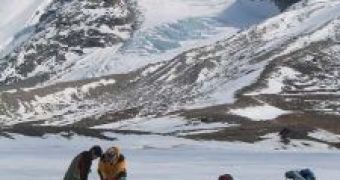Arctic lakes sediments are like a climate recorder that can display to our knowledge all we wanna know about the weather experienced by our ancestors in order to understand how will the Earth warm in the coming years.
Now, a Canadian-American group is gathering the first quantitative temperature data over the last millennium investigating data recorded in meters of mud depth from the extreme northeastern Canadian Arctic, such as Baffin Island.
"As paleoclimatologists, we want to study Earth under conditions similar to those we have today, what we call 'climate analogues,' which might tell us what to expect in the future," said Dr. Jason P. Briner, assistant professor of geology in the College of Arts and Sciences at the University at Buffalo.
"The Arctic as a region is an excellent harbinger of future change, Briner said, because the signals or clues that signify climate change are so much stronger in the Arctic than elsewhere on the planet."
"Yet, even when we take that phenomenon into account, the signals we're finding on Baffin Island are huge," he said. "The temperature records, that is, the 'signal' of warmth that we're reconstructing for this part of the Canadian Arctic over the past 10,000 years seems to be higher than the global average for that period and even higher than the Arctic average."
The warmest period of the past 10,000 years, after the last glaciation, meant about one degree more on global scale, but in the Arctic average temperature was two to three degrees warmer than it is now. "But based on lake sediments from Baffin Island, our data show that this area of the Arctic experienced temperatures five degrees warmer than today," said Briner.
"Because Arctic regions show such strong seasonality, it's relatively easy to correlate climate changes with very fine layers in the sediments. In some lakes, each layer represents one year, with thicker sediment layers generally signaling warmer summers", explained Briner.
In fact, the current global warming is more pronounced in the Arctic than in other areas of the Earth. "The magnitude of warmth over the past 100 years seems pretty exceptional in the context of the past 1,000 years," he said. "Whereas maybe an average of all of the instrument data from the globe shows just a half a degree increase in this century, in the Arctic, temperatures went up by two to three degrees in the same period. The rapidity of the change also is exceptional," he added.
"If we look at the temperature graphs that we've generated for the past 1,000 years for this region, the temperatures wiggle back and forth, so there is a little variability in there," he said.
"However, in the past 100 years, both the magnitude and the rate of temperature increase exceed all the variations of the past 1,000 years."
Drilling for probes was done in May, while still winter in Baffin. "The beauty of lake sediments is that they're being deposited continuously right up until yesterday, so by looking at them, we get clues into past climates, which we can then overlap with records from weather stations, which only cover the past 50 to 75 years."
The mud samples are investigated for isotopes, fossils and organic material represented by the accumulation of dead organisms and algae. "Generally, the more organic matter in sediments, the warmer the climate," said Briner.
The scientists would like to depict the spatial variability when investigating past climate records. "Everyone knows the climate is extremely variable, spatially," said Briner. "For example, earlier this year, Colorado got slammed with snow and Buffalo didn't get a flake. It's the same when we reconstruct past climates: maybe the climate cooled by 30 degrees in Greenland but only 10 degrees in the area that's now Buffalo."
"Reconstructing this spatial variability will help develop a more precise view of how past changes in climate have affected the planet, providing a guide for how the current global warming trend may unfold".
"We can use these patterns to test climate models," said Briner. "Once models can adequately predict past climates and their spatial patterns, then we have confidence that they work and so can be used to predict the future."

 14 DAY TRIAL //
14 DAY TRIAL //